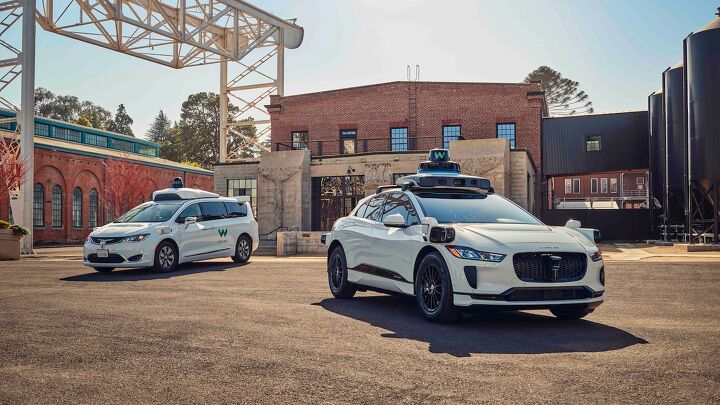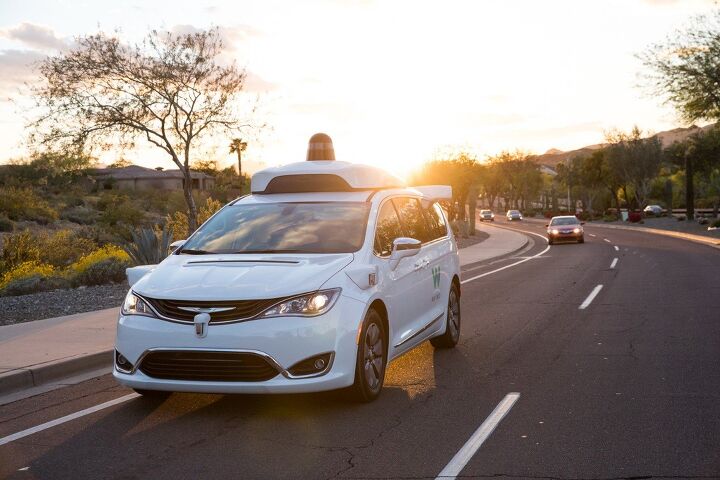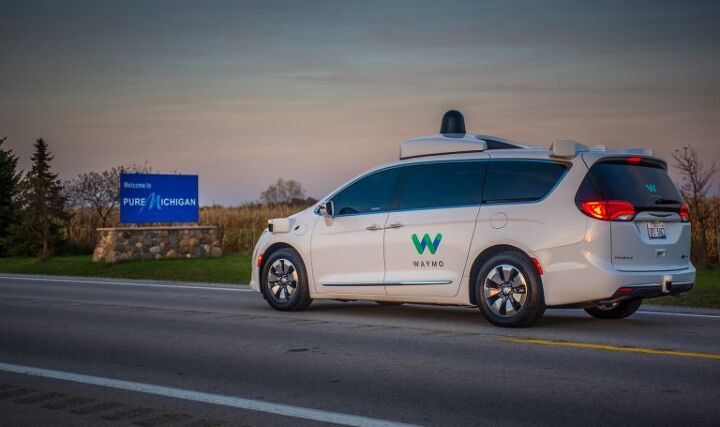#Waymo
Driverless Cars Cause Headaches for First Responders
Driverless cars for everyday drivers do not exist, but a handful of cities in the country have allowed companies like Waymo to begin limited testing of autonomous taxis and other vehicles. Tech-heavy San Francisco is at the forefront of the movement, but its time with robo-taxis hasn’t been without drama.
Waymo Briefly Sidelines Test Vehicles Due to Fog
Waymo, Alphabet’s self-driving unit, reportedly had some of its San Francisco-based test vehicles stymied by dense fog earlier in the week. Compared to some of the other incidents we’ve seen attached to autonomous test cars of late, the fog delay seems to be the most minor of mishaps. However, it’s another reminder that a lot of the systems AVs use to "see" have yet to overcome inclement weather.
The Self-Driving Industry Looks Unwell, Waymo Layoffs Begin
Alphabet subsidiary Waymo has reportedly leaned into layoffs and everyone is wondering whether this is an offshoot of the 12,000 job cuts being made at Google or indicative that self-driving tech has run itself into a brick wall. While there’s certainly a wealth of evidence that autonomous vehicles have progressed more slowly than the industry would have had us believe a decade earlier, Waymo has arguably made some of the biggest strides in the industry.
Not Everyone in Arizona Is a Fan of Waymo's Self-Driving Vans
Waymo, the autonomous program backed by Google-parent Alphabet, seems to have upset some residents of Phoenix, Arizona, who have elected to whip eggs at the company’s test vehicles. Selected due to its lax regulatory standards, the state has become home base for Waymo to pioneer its self-driving vans since 2016. However, newly released police reports paint a picture where the locals are far less enthused with the vehicles’ progress than Waymo’s marketing materials would suggest.
A subset of Phoenix citizens has been demanding the firm improve transparency and offer better explanations for some of the higher-profile crashes since 2018. Despite Waymo assuring the public that mishaps are rare, local reports showed some erratic behavior among the test mules operating in 2020. While a few of these incidents made the news, local police reports from Chandler and Tempe (metropolitan Phoenix) indicate there was a slew of incidents we did not know about — many of which involved encounters with frustrated, human motorists.
FCA Strengthens Relationship With Waymo; ProMaster On Deck
Fiat Chrysler Automobiles and Waymo jointly announced plans to expand their autonomous driving partnership on Wednesday, with a new focus on delivery vehicles. The Google affiliate already uses Chrysler’s Pacifica as the primary testing platform for its autonomous taxi services, and it appears it isn’t eager to rock the boat, now that it needs something more utilitarian as it moves toward SAE Level 4.
While not completely self-driving, such vehicles would be capable of performing all necessary tasks under certain conditions. They may be designed for a specific purpose and lack traditional vehicle controls. Waymo seems to think they’d be ideal units for transporting goods and has asked FCA to hand over Ram ProMaster vans for conversion into test mules. It also asked the automaker to become its sole partner on the project — which is assumed to carry over once the company merges with Groupe PSA to become the Stellantis corporation.
Former Uber Self-driving Head Declares Bankruptcy
The former leader of Uber Technologies’ self-driving unit, Anthony Levandowski, filed for Chapter 11 bankruptcy on Wednesday, and it looks to have something to do with the $179 million he’s legally obliged to pay Google. A San Francisco County court decreed the same day that Anthony needs to pay out in order to settle his contract dispute.
In December, it was ruled that Levandowski and Lior Ron violated their agreement with Google when they left the company to start Otto — a rival autonomous vehicle company focused primarily on commercial trucking. Uber purchased Otto in 2017 but Google’s self-driving arm (which evolved into Waymo) claimed Levandowski violated intellectual property laws by stealing trade secrets it owned for Uber. While Ron decided to pay $9.7 million to settle with the tech firm, Anthony held out. He also faces a federal indictment over the alleged intellectual property violation.
Waymo Raises $2.25 Billion in External Funding Push
Waymo CEO John Krafcik announced Monday that his company amassed $2.25 billion in its external investment round. Considering Waymo is owned by Google parent Alphabet, one of the richest companies in the world, you’d think it’d be able to float some extra funding into autonomous development. However, even a company worth an estimated $1 trillion knows it’s better to source capital from outside the business — that must be on the first page of every tech company’s playbook.
Seen widely as the firm currently riding the tip of the autonomous spear, Waymo already operates self-driving shuttle programs (with a safety driver) in Arizona, with plans for expansion. The new funding aims to further those goals; however, with autonomous targets being missed by just about every company that bothered making them, we’ll wait to see what happens. The company is currently focused on getting its Waymo Driver system into more vehicles, starting with EVs and Class 8 trucks.
Waymo Refocuses on Semis, Heads Back to Phoenix for Testing
Alphabet’s Waymo probably operates the most successful autonomous fleet in North America right now. While we can debate its technical prowess versus its rivals forever, it’s still one of the only companies offering a commercial taxi service using autonomous vehicles in North America. It also has an enviable safety record.
The company has also worked on adapting the technology for Class 8 trucks, testing such units previously in California, Atlanta, and Arizona. Recently, the company tweeted that self-driving semis would soon return for more testing in Phoenix — where it runs its Pacifica-based early rider program — as the company places a renewed emphasis on their development.
Waymo Picks Detroit Plant for Self-driving Vehicle Conversions
It’s a long way from the company’s fledgling, Phoenix-area autonomous ride-hailing service, but Detroit has enough available space and local talent for Waymo to sign a lease.
On Tuesday, the self-driving tech company announced a deal to mate Chrysler Pacificas and Jaguar I-Paces with autonomous hardware in an abandoned assembly plant sitting in the heart of the domestic auto industry.
California Gives Ford's Argo AI Green Light to Test AVs
Argo AI, the Pittsburgh-based firm Ford pumped $1 billion into and handed responsibility for educating its self-driving vehicles, just received a go-ahead for testing in the State of California. The company gained a testing permit from the California Department of Motor Vehicles on Tuesday, making its autonomous trials perfectly legal on public roads.
Ford’s current trajectory has its autonomous vehicles entering the commercial market by 2021. That’s two years after General Motors promised to do the same. However, recent events cast doubt over whether GM will be able to meet its self-imposed deadlines (some of which dictate future investments from its partners) and start mass production of computer-controlled cars by the end of this year. It’s not just GM that’s having trouble, either. A critical look into autonomous development shows many companies are struggling with advancing the technology to a point that would make it commercially viable.
The Blue Oval might be better positioned in the autonomous race than initially presumed.
Waymo Promises New Auto Jobs in Michigan
Alphabet’s self-driving arm, Waymo, announced plans for a Michigan expansion on Tuesday. The company is currently seeking a location in the southeast section of the state and intends to hire up to 400 employees over the next five years.
According to a corporate blog post, the new new hires will be tasked with installing autonomous driving systems on vehicles built by Fiat Chrysler Automobiles and Jaguar Land Rover ahead of those vehicles entering the firm’s growing fleet.
“We’ll be looking for engineers, operations experts, and fleet coordinators to join our team and help assemble and deploy our self-driving cars,” the blog explains. “This will be the world’s first factory [100-percent] dedicated to the mass production of [Level 4] autonomous vehicles.”
Guns, Drunks, and Rage: Waymo Self-driving Vans Targeted by Angry Arizonians
Waymo began testing its self-driving Chrysler Pacifica minivans in the Phoenix-area city of Chandler, Arizona two years ago, and the local populace hasn’t left them alone since.
A report in the Arizona Republic describes a multitude of incidents where citizens, apparently enraged by the sight of the Waymo vans, decided to threaten and attack their autonomous invaders. Unbeknownst to many of them, the vans were recording their every move.
Work in Progress: Waymo Van Stakeout Reveals the Challenges of Self-driving Tech
The self-driving Chrysler Pacifica vans operated by Alphabet-owned Waymo didn’t know they were under surveillance, but indeed they were. Reporters from the Arizona Republic were on their tail, watching as the autonomous vans — safety driver behind the wheel — tooled around the streets of the Phoenix, Arizona metro area for a period in October. In total, the rolling stakeout covered 170 miles of sun-drenched roadway.
Earlier this week, Waymo announced it had become the first company to offer a commercial ride-hailing service (“Waymo One”) using autonomous vehicles, even though there’s still a live human being behind the wheel. That employee’s job is to monitor the vehicle and take over if needed, as self-driving tech is still in its early days. There’s bugs to be worked out.
What the newspaper’s surveillance showed was that vehicles operating “by the book” — ie, with a strict adherence to the rules of the road and an abundance of caution — sometimes don’t mix well with humans. Go figure.
Waymo's First Commercial Self-driving Service Launches in Phoenix
We’ve arrived. It’s officially #TheFuture.
After years of talk within the auto industry, Waymo says it will become the first company to offer a commercial taxi service using autonomous vehicles when the program launches in Arizona today. Called Waymo One, the Google subsidiary plans to offer the first batch of rides to the 400 individuals who participated in the firm’s pilot program. Afterwards, the service will be expanded to more riders in a broader area.
As with the company’s early rider program, Waymo wants to keep the launch small to assess demand while continuing the company’s testing in an environment it feels comfortable with. Based on the growing assumption that autonomous vehicles can’t handle inclement weather, Arizona seems like the perfect place to keep working out the bugs.
Similarly, public complaints have indicated Waymo’s fleet of Chrysler Pacificas may not yet be perfected.
What Does Ford Look Like As a Mobility Company?
These days, every automaker is in the midst of a metamorphosis, eager to emerge from their chrysalis as a “mobility company.” Even brands that don’t seem bent on completely revolutionizing their business model now use the term in reference to themselves.
Ford, which has positioned itself as a mobility company ever since Mark Fields was steering the ship, is among those pushing the narrative the strongest. Fields may have been fired for having a lofty, tech-focused vision that couldn’t charm investors, but much of it carried over to Jim Hackett’s tenure as CEO. Ford desperately wants to be seen as a cutting-edge nameplate.
However, the assumption among industry experts is that it’s lagging behind General Motors in terms of autonomous driving, electrification, and the ability to tap into alternative revenue streams. We sometimes wonder how accurate those assumptions are.




























Recent Comments